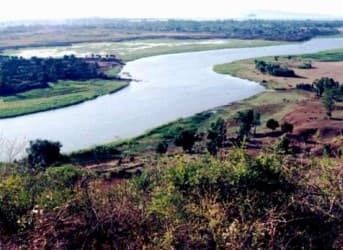In East Africa, the major water resource is the Nile river, the world’s longest, at 4,130 miles, referred to by Egypt since antiquity as the country’s heart.
The past several decades have seen the mighty river’s water flow increasingly contested amongst the river’s eleven riverine states.
Three months ago, Egypt’s recently deposed President Mohammed Morsi said, “Egypt is a gift of the Nile, and the Nile is a gift of Egypt,” and promised that he was ruling no options out concerning its future. Morsi’s comment should carry some weight, as Egypt is the most populous and most militarized nation on the Nile concourse.
Upstream states are increasingly eyeing the Nile’s headwaters as a source of hydroelectric power, with the latest contender being Uganda.
Uganda is constructing a new 6o megawatt hydroelectric dam on the White Nile. The Karuma Hydropower dam will cost $1.4billion and will be built by China’s Sinohydro Corp.
On 12 August Uganda's President Yoweri Museveni praised Chinese investors at the inaugural ceremony, noting that they had the technical expertise and money to fund infrastructural projects and provided finance on favorable terms, "completely free of the usual meddling and high-handedness of some of the friends from outside." Further lauding Chinese involvement Museveni noted that the Chinese were focusing on "primary sectors of the economy such as infrastructure instead of focusing on secondary sectors of national life."
The country could use the facility, as the Uganda Electricity Transmission Co. states that Ugandan demand for electricity is currently surging by 15 percent annually.
Ethiopia is also scrambling to get into the hydropower shuffle. Ethiopia is the source of 80 percent of the Nile’s waters and now intends to impose its own vision for the river, which would entail a different division of its waters.
Related article: Terrorism: The Latest Salvo on LNG Exports
Both states’ power divisions will likely increase tensions with Cairo, as Egypt is entirely dependent on other states for its water, almost all of which comes from the Nile. The Nile’s four principal sources rise several hundred miles beyond Egypt’s southern border: the Blue Nile, Sobat and Atbara in Ethiopia, which provide around 80 percent, and the White Nile in Uganda, which provides the rest.
Egypt relies on the Nile for most of its water supply and Ethiopia’s Lake Tana is the source of the Blue Nile, which contributes 86 percent of the water arriving at Egypt’s Aswan High Dam. The White Nile’s main source is Lake Victoria, whose shoreline is shared by Uganda, Tanzania and Kenya and which joins the Blue Nile south of Khartoum.
Nile water access issues are rooted in history, as nearly a century ago Britain, as East Africa’s dominant colonial power, effectively handed Egypt the lion’s share of Nilotic waters in a 1929 accord. Under terms of the agreement Egypt had and currently maintains its historic right to three-quarters of the Nile’s water, 55.5 billion cubic meters that it annually diverts of the Nile’s total flow of roughly 84 billion cubic meters. Under the 1929 agreement Sudan was apportioned a further 11 percent of the Nile’s waters, leaving the other littoral states to share the remainder. Under terms of the accord Egypt has persistently vetoed neighboring countries' rights to build dams or irrigation projects upstream which might affect the river's flow.
In 1959, when Egypt and Sudan were independent and but all Nile upstream states except Ethiopia were still colonies, Egypt and Sudan signed a bilateral convention that essentially reaffirmed the 1929 accord, under which Egypt received 55.5 billion cubic meters a year and Sudan 18.5 billion, leaving only 10 percent of the Nile's water to the upstream countries. The convention argued that upstream nations had significant rainfall, unlike Egypt or Sudan.
Related article: What Does the US Want in Egypt?
Instability, poor governance, lack of finances and the availability of other water sources left the issue largely dormant until the 1990s, when Nilotic governments seriously started to consider using their Nile Basin waters to generate energy and irrigate crops.
Now the Nile’s current annual flow averages 84 billion cubic meters, 10 billion of which evaporate from the Aswan High Dam’s Lake Nasser reservoir, created when the dam came into operation in 1964.
Not surprising then, that most African countries, where only about 25 percent of the population is connected to electricity grids, are seeking any and all electric power sources.
Guaranteeing an ongoing and increasingly fractious source of tension for Nilotic states.
Ethiopia has begun a number of hydroelectric projects, including the 1,870 megawatt $2.2 billion Gilgel Gibe III dam on the Omo River and the proposed 5,000 megawatt $5 billion Grand Ethiopian Renaissance Dam, formerly known as the Millennium Dam, on the Blue Nile.
While both have attracted international criticism, Ethiopia’s Ministry of Water and Energy Sector Mapping and Database Development office has determined that the country’s wind potential could generate 10,000 megawatts annually, which has not yet been developed.
So, how to proceed on the contentious issue? With the current political turmoil roiling Egypt, Cairo’s ability to influence upstream states is currently constrained, which until the dust settles may well provide Egypt with a number of aquatic fait accomplits.
If Kampala and Addis Ababa press forward with their hydroelectric projects in the interim, then they will probably eventually face some “frank and candid” diplomatic discussions with Egypt, which, after all, has a 4,000 year old history of Nile concerns. Not a happy scenario.
By. John C.K. Daly of Oilprice.com


















